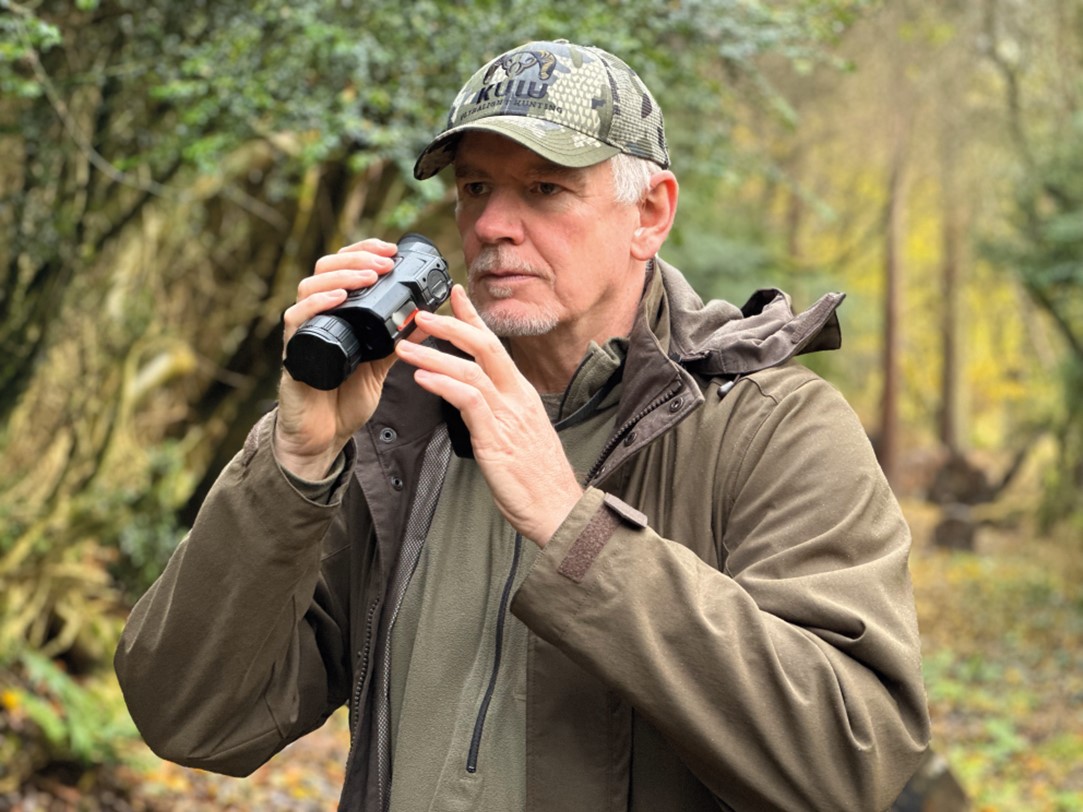Paul Austin field tests the long-awaited successor to the original FH35R thermal spotter
I’ve always been a big fan of the Finder series – the original FH25R was a real milestone in terms of thermal LRF. Admittedly the LRF element on the original Finder was a bit hit and miss in terms of ranging, claiming a maximum ranging distance of 600m, which in reality was only dependable up to 350m, and even then it could take a few pings to secure an accurate reading.
The original FH25R certainly wasn’t perfect but the form factor was fantastic. It was a tiny unit offering great field of view and an impressive 640 sensor alongside a good quality thermal image, especially given its relatively small 25mm lens. It wasn’t really a direct challenger to the all- powerful Pulsar LRFs but it was certainly a viable and much cheaper pocket-sized alternative.
It was succeeded by the superb FH35R, a device that’s been my go-to thermal spotter for a couple of years and the benchmark against which I test all other ‘sensible money’ spotters. This big brother of the original Finder had a 35mm lens and all-round improved performance, especially in terms of the LRF.
For this latest V2 release it has been beefed up very slightly, but side-by- side the two look virtually identical.
The base mag remains the same at 3.4x. Ideally I like spotters in the 2/2.5x range in terms of base mag, but that isn’t a deal-breaker for me. As a package it’s one of the best thermal LRF systems on the market, especially when spotting at extended range over large areas.
Like its predecessor, the LRF offers the same powerful pinger that can quickly and reliably reach out to the advertised 800m max range. Equally important, the 35R family of Finders feature swappable Li-ion batteries, two of which are included. This ability to reload in the field with a simple battery swap is a major selling point.

FORM FACTOR
The FH35R definitely loosened its belt a little, growing by perhaps a third in relation to the FH25R, largely to accommodate the bigger 35mm lens and provide space for the battery port. Even so, it’s still a compact design that can easily slip into a pocket. The new lens continues to be protected by a permanently attached solid lens cover rather than the rubberised version of its smaller sibling.
There’s a micro-HDMI video-out plus a charging port alongside a USB and file transfer, whether that be for stills or video, with or without audio. So it’s a very good choice for truck-mounted observation. Most file transfers (and obviously all streaming) will be handled via wi-fi by connecting to your smartphone and the associated InfiRay Outdoor app, which has seen multiple iterations and is now nicely implemented.
HANDLING AND FUNCTIONALITY
The new sensor is the only major change from the original to the V2, but it’s a big one! Sub-35mK NETD has now been improved to sub-20mK. The f1.0 35mm lens has been upgraded slightly to an f0.9 and it’s impressive, as is the 50Hz refresh rate, battery life, PIP functionality and built-in storage. In terms of ergonomics and navigation, it’s pretty much identical to its predecessor, with the same button layout and basic menu system.
Admittedly navigation isn’t quite as intuitive as in some devices, with a few extra clicks required to access certain features. But to be fair, after a couple of trips you soon get used to delving a little deeper to access the magnification and colour palettes, alongside the four levels for brightness and sharpness.
All the buttons are dual function with the familiar short and long presses activating or flipping between functions, all of which becomes straightforward after a couple of outings. If I could change anything I would make the buttons themselves a little more prominent, as there can sometimes be a bit of fumbling around to find the one you want.
IMAGE QUALITY
The new 640x512 ≤20mK sensor provides a serious improvement over what was the impressive performance of its predecessor. The 35mm lens also plays its part in poor thermal conditions and holds up better in damp weather.
The most noticeable difference is in the detail, whether that be environmental or on the prey. To use a photography term, the image isn’t as soft; there’s more texture across the board and that translates into a device that delivers better identification rather than just detection. The original FH35R was great, but in terms of image quality this is a good deal better.
In its class it’s as good as it gets. The traditional high-contrast InfiRay image (which you may nevertheless prefer) still falls slightly short of the high-end Pulsar Mergers in my opinion. However, we do need to put this into perspective. The Pulsar line does have a higher NETD. The larger lens is also a bonus, admittedly, as is the 1000m ranging, but to get all of that you need to invest a lot more cash over the asking price of the very impressive FH35R V2.

SPECS
Sensor: 640×512, 12μm, NETD 20mK
Objective lens: 35mm, f0.9
Magnification: 2-8x
Detection range: 1818m
Wi-fi and app support: Yes
Resolution: 640×512 pixels
Frame rate: 50Hz
Objective lens: 35mm
Field of view: 12.6×10.1°
Magnification: 2-8x
Digital zoom: x1/x1.5/x2/x2.5/x3/x3.5/x4
Display resolution: 1024x768 pixel OLED
Thermal palettes: Black, White, Red Hot, Rainbow
Replaceable battery pack (6 hours runtime): 2 included
Built-in memory: 32GB (with audio)
Laser rangefinder (single and continuous): 800m
www.highland outdoors.co.uk